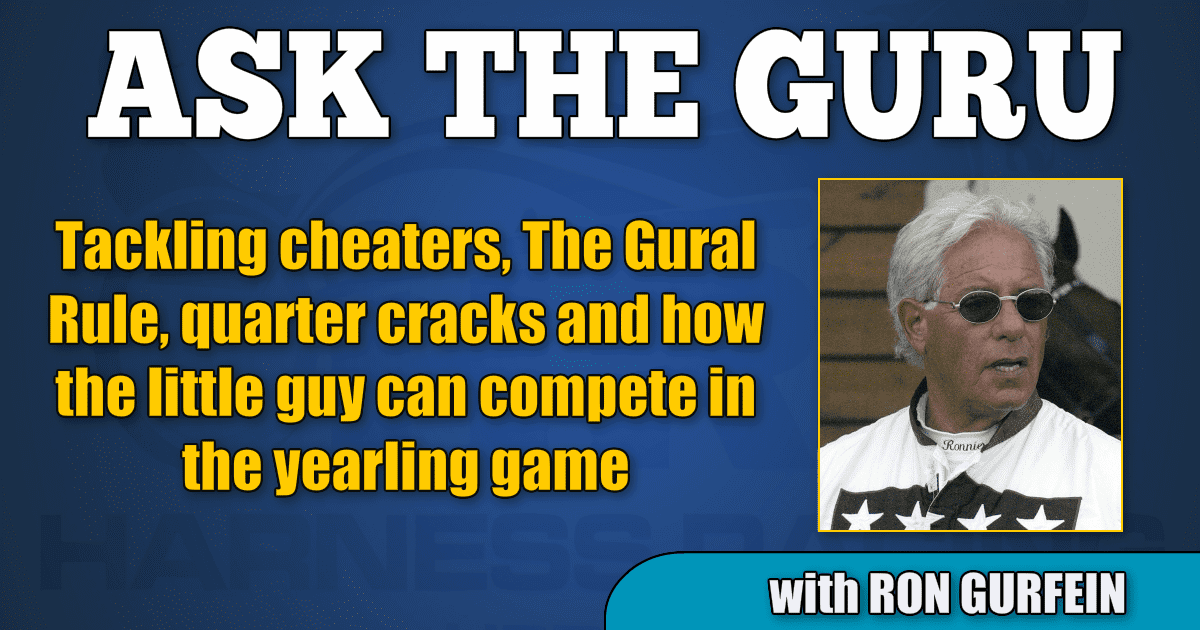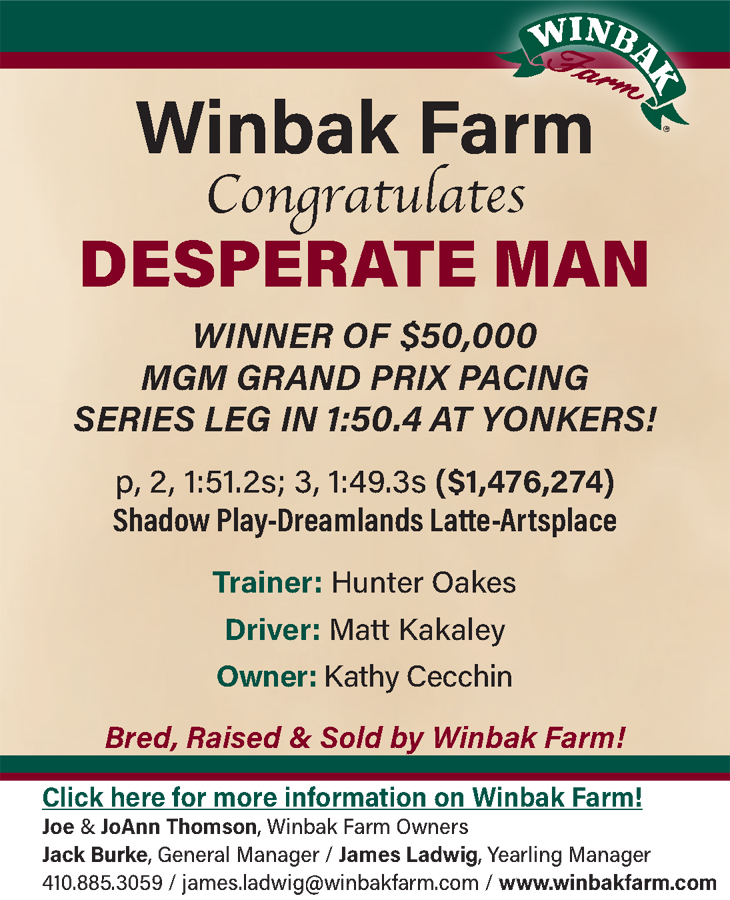Tackling cheaters, The Gural Rule, quarter cracks and how the little guy can compete in the yearling game
by Ron Gurfein
Tidbits: I have almost finished my first year-end column that I will name “The Good the Bad and the Ugly of 2018.” I hope you enjoy reading it as much as I did writing it.
Don Theriault asks: Why does it seem like the cheaters in harness racing are always a step ahead of the testing methods? You hear of trainers profiled as cheaters being banned from certain tracks but you don’t often see them in the USTA’s Fines and Suspensions list. Do you think the testing methods are sufficient enough to properly police the sport?
When money is involved in any sport, not just ours, there will always be people that push the envelope. There are no sports where some cheating drama hasn’t reared its ugly head. In my lifetime, I have actually witnessed a time when horsemen stuck together and rid the sport of a brutal cheat. In the seventies there was a thoroughbred trainer that was stepping up claimed horses at a ridiculous rate. His name was Oscar Barrera. He was so blatant that the horsemen in New York went to Kenny Noe, the race secretary at Belmont Park and said we have had enough we refuse to race against him. If he puts an entry in the box take us out and the race can’t fill. He never raced again. There is a new Oscar Barrera in thoroughbred racing, yet he is not that blatant to warrant action like New York.
Training harness horses has become so state of the art I am sure we are crucifying some individuals who simply work harder and have a better system than others. I am not saying there aren’t cheats out there that are using illegal drugs, but we must be very careful not to have a recurrence of what happened to Lou Pena in New York. To me it was just as bad as the police planting evidence on a known drug dealer to get a conviction. Cheaters are not always ahead of testing methods, they just seldom get caught. With the amount of money spent on drug development in our country it provides an impossible atmosphere to keep ahead of the cheaters. The expense of testing properly is enormous. There are many jurisdictions that skimp on testing and somehow the bad guys always know what is being tested and what is not.
As far as the Fines and Suspensions list missing some of the banned trainers, if you look hard enough you will find them. State-owned racetracks are not so keen on eliminating trainers because of lengthy lawsuits, but private entitles seem to pull the trigger when they feel a trainer doesn’t live up to the ethics of the racetrack.
In my opinion, testing methods can never keep up with the lower element of our business. I would like to see the horsemen themselves take a stand whether it be like Belmont in the seventies or form a committee to self regulate the problem. So many good trainers suffer from this situation. I applaud the efforts in Ontario to rid the tracks of trainers with overloads of positives. They are headed in the right direction.
Conventional testing is definitely not the answer. Severe Out of Competition testing is a start. My belief is that if we take all the money we waste on detention barns and use it for policing and out of competition testing it would go to much better use.
Dr Aled Thomas asks: Whilst “The Gural Rule” was introduced to prolong the racing career of some of the sport’s biggest names in order to attract new fans, it seem that the majority of colts are still retiring at three. Has the rule made any difference to the older pacing and trotting divisions?
Jeff Gural is a good friend and will go down in history as an innovator and risk taker that has saved the sport of harness racing as we know it.
That said, The Gural Rule was an ill-conceived measure. The concept had merit but in actuality it just cost a lot of people a lot of money. In order for this rule to have value, the 4-year-olds would have to race way more than just one year to have any impact. Racing aged talented and tough FFA stock is above the pay grade of a 4-year-old. They just can’t seem to adjust that quickly and are at a tremendous disadvantage. Once in a while there will be an exception but not often.
Art Zubrod manager of Brittany Farms said, “how much more money would Marvin Katz and George Segal have poured into the business if Father Patrick and Captaintreacherous had gone to stud at three… I don’t think anyone can point to any benefit that the industry has gained from this rule.”
Not only did the rule cost them a year, but it also cost them in popularity. Neither one had their stock go up after racing an extra season.
Jeff is a bright guy and I really think that if someone had sat down with him and explained that in order for his plan to work the horses would have to race through five and beyond, he would have reconsidered.
The only instances of any change in the older divisions was because of a horse being less fertile than need be for stud duty or lack of interest on the part of the breeders.
Robert Bresnahan asks: Does a small trainer like myself buying have a chance buying two to four yearlings a year with a $50,000 to $100,000 budget or should I stick to racehorses?
If you know what you are doing and know how to select a colt you will be fine. I started racing $1,500 claimers in Monticello. Don’t think that guys like me, Takter or Sylvester started with 40-horse stables and high-priced yearlings. There is a great line from the movie Field Of Dreams, “If you build it they will come.” Apply that to “reputation” and you will learn a few correct purchases can get you launched. I started out training yearlings that cost under $ 10,000 for the first 10 years of my career and graduated to under $20,000 for the next 10 years. If the highest-priced yearling was always the best, no one would be buying horses. I won the Hambletonian with Victory Dream, a $40,000 colt, Chuck won it with Mack Lobell, a $17,000 colt, I won the Merrie Annabelle with Vernon Bluechip, another $17,000 purchase. Verlin Yoder has an undefeated trotting filly and Joe Holloway has a top pacing filly — both were well in your price range selling in the $30,000 area.
Is it easier if you have $3 million to spend? Of course it is, but you have to start somewhere. However I wouldn’t give up my racehorse stable. You need to generate income in both places in order to stay above water. If you don’t, and you have a bad year with colts it will be a very lean summer.
Jeff Cantine asks: Would you please discuss your approach to dealing with quarter cracks?
Before dealing with fixing them let’s talk a little about preventing them. The most important aspect is to keep the colt’s foot supple. By that I mean that the hoof should have some softness to it and not be rock hard. Picture what it would be like if the skin on the bottom of you foot was taught every step would hurt and eventually the skin would crack. Keeping the foot growing at a normal rate and applying proper foot care products is the answer to a nice malleable hoof. I don’t want to name products because of conflicts with advertising, but your vet or harness shop will get you the best hoof growth and hoof packing ingredients.
Next we must keep the foot level. Trouble lies ahead when your horse is landing in an uneven manner as toe first or heel first. You can figure this out by looking at his worn shoes and they will show where the horse is landing first as that part of the shoe will be more worn than the rest. Your blacksmith will adjust him to land correctly. To me the most important part of shoeing to prevent cracks is to make sure that the shoe ends at the bars of the foot and don’t cover them. I have seen way too many instances where the shoe covered the bar, absolutely an accident waiting to happen.
As for fixing a quarter crack it really depends where it is. I personally never had much luck in patching a crack that is in the bar of the foot. It is a convoluted method that applies too much pressure to the heel. For bar cracks, I suggest cleaning it out and hand walking or stall rest till it can be manageable when jogging. For your run of the mill every day quarter crack, I prefer the Ian McKinley method of wiring the foot together and covering the area with fiberglass for support. There are many very capable blacksmiths available to do this sort of work. I have had horses patched in this fashion and race the next day and were perfectly sound.
Thanks to all of you for your kind words. I realize that it’s holiday season and that you all are very busy, but please keep your questions coming in and if you have any special requests for the Good the Bad and the Ugly of 2018 email me ASAP so I can include your thoughts in the year end column next weekend. Have a wonderful week.
Have a question for The Guru?
Email him at [email protected].

















